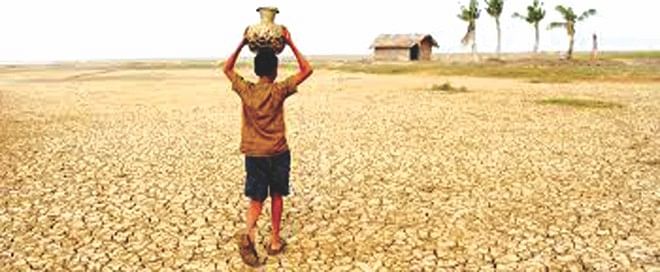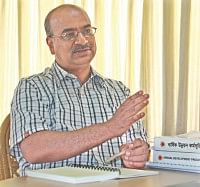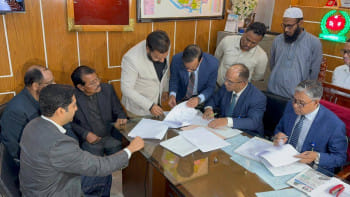“Access to safe potable water has not been termed as human rights in the Bangladesh Water Act 2013”

The interview was taken online by Shahnoor Wahid
Please tell us about the fate of the proposed Water Act. Is it moving in any direction?
Bangladesh Water Act 2013 has been enacted in the parliament in May 2013. The Executive Committee of the Water Resource Council was formed in October and the National Council was formed in last February 2014. However, to the best of my knowledge, committees are yet to meet.
Are you happy with the act?
We have been pursuing its formulation for the last few years. Bangladesh has voted for UN resolution 2010 which provided access to safe water and sanitation as human rights. However, access to safe potable water has not been termed as human rights in the Bangladesh water act 2013. Even the penultimate version of the act had considered access to safe water as human right. We don't know what happened between the penultimate version and the version endorsed in the parliament. We are disheartened to see that the Government's stand in the UN general assembly and in its own parliament are not similar. Despite it is an important landmark that we have an approved water act in the country.

What are the challenges now?
Now the challenge is operationalization of the act. WARPO is the focal body to operationalize the act. It is basically is a centralized organization. It has very limited capacity. Although SDC is supporting WARPO to enhance its capacity we are apprehensive that without delegating responsibility to the Local Government Institutions – it would be extremely difficult for WARPO to operationalize the act at the ground level especially in rural areas. As an example, as of now, in order to protect a pond for drinking water purpose in a union of ShyamnagarUpazila under Satkhira district, one has to convene a meeting of the Executive Committee of the Water Resource Council which comprises of 7 Ministers and 8 Secretaries and so on. It could have been easily done at Upazila level. The committee needs to immediately delegate many responsibilities to the local government; sooner the better. The most critical part will be to address the issue of over extraction of ground water. It is not clear how this will be monitored and controlled. The committees need to do a lot of works in the coming years.
A few words about progressive tariff for our readers.
We started talking about progressive water tariff for a number of reasons. We strongly feel that the existing tariff system is highly biased towards the rich who are served by the public utilities. We also feel that the existing flat rate of water is the main reason of prevailing water misuse; and perhaps one of the leading causes of water shortage that we experience in Dhaka city. In the present rate, you buy one thousand litre of potable water for just little over seven and a half taka or one litre of water for just 0.007 taka. To be honest, this is not even the production cost of water. Our tax money is being used to provide this subsidy. This ultimately means that you are subsidizing water to encourage people to use (or misuse) more water. So, what happens as a result? You flush your toilet as many times as you may need, or wash your car, water your garden with potable water while there are many people, which is about one third of the total population of the city, living in the slums pay roughly 200 times more than this rate to collect water from the informal sources to meet their thrust.
We think that this should not continue forever. So we propose that a progressive tariff system needs to be introduced, based on the principal of “more use more pay”. Some argue that if we purchase in bulk we should get wholesale price. That may be true for products which are for profit. This cannot be the principle for product and services which are subsidized by the state. If someone wants to wash his car with potable water, s/he is free to do so but it shouldn't be so cheap for him. This is not a difficult deal. You make slabs, for example, the way electricity slabs are working – keep the basic demand level still in the existing rate and subsequently increase the rates for each slab progressively. We did a hypothetical estimation which suggests that Dhaka WASA can generate additional annual revenue of at least Tk 500 cr if a very soft kind of progressive tariff system is introduced. This on the one hand will prevent misuse of water; thus, WASA do not have to spend more money to increase supply. On the other hand, the increased revenue could be used to bring the poor slums dwellers into the service coverage. To conclude, our position on this is to bring efficiency in the water management as well as promote justice in the water governance.
The issue of discrimination and urban-rural disparity in making fresh water available to the people often comes up in discussion. What is your take on this?
We have been monitoring the public sector allocation and expenditure for water and sanitation for over the past several years and we are surprised to see huge discrimination between rural and urban as well as within the urban. In the FY2008-9, the allocation to rural areas was 30% of the total allocation for water supply and sanitation. Since then, it has been gradually decreasing. Allocation to rural areas came down to as low as 5.9% of the total allocation for water and sanitation in FY 2011-12. On the other hand, although the urban areas receive the bulk of the public sector allocation, but most money unfortunately goes to the big cities. In the FY 2011-12, six big cities received almost two-third of the total allocation that went to the urban while the rest of the cities and municipalities altogether got 25.9%. Further disaggregation of the allocation in the same FY suggests that among the six big cities, Dhaka and Chittagong eats away almost all the money, 54.2% and 37.1% respectively. If we look at the project lists of these two cities, you will be surprised to see that all the big budget projects are to service the rich people, either to replace the old sewerage network or bringing new settlements into the coverage. There is hardly anything to service the poor who are more than one third of the total population of the city and key to the economy of the cities.
Questions are often raised by relevant quarters as to why WaterAid is not active in Arsenic Mitigation, Please give your comments.
I accept the criticism. Not only WaterAid, most of the development actors are less active in the field of arsenic mitigation. The initial hype has come to a plateau and it is now declining. As an INGO, we cannot ensure resources for decade after decade for a particular issue. Since the Government is the main development actor, we rely on them. There has been a promise made by our Finance Minister in the High Level Meeting in Washington in 2010 that an arsenic fund will be created worth 200 million dollar. We are yet to see this being fulfilled.
What is your take on the theme of the world water day 2014 – water and energy?
Well, we have just celebrated the World Women's Day. We talked a lot about empowering women. Now think of the situation in Dhaka city and any village in Bangladesh especially the coastal belt and Chittagong Hill Tracts. In Dhaka water is being extracted by Dhaka WASA with electricity, pumped to the pipeline, you have another pump in your household which uses electricity to lift the water in the overhead tank; you open up your tap in the toilet or kitchen and you get running water. All these electricity are subsidized. Now just think of the rural areas, coastal belt and CHT. Women are pumping the hand pump or tubewell; many of them walk for 20-30 minutes or a few kilometers to fetch a pitcher of water. How much calorie which is basically a measure of energy these poor women are spending? In CHT, waking against gravity is more energy draining than in the plain land. Just imagine that we are compelling our rural women to spend part of their hard earned energy for collecting water. World Water Day is concerned about energy from water and vice versa; however, I am yet to see this energy dimension in the discussion. Our development mind set always propose low cost yet high human energy dependent solutions for rural poor and women; and sophisticated technology for the city dwellers with subsidy from the state. We need to change our mind set. In water; low cost technology is not always low cost rather tolls on poor's hard earned energy. This is an equity issue. We keep celebrating one after another global or international day. Now we need to relate one with another and think comprehensively – how long the burden of water will fall on adolescent girls and women? We need to bring a change in our water resources management.
(Khairul Islam is one of the leading public health professionals and development workers of Bangladesh. He has worked in various capacities in different development organizations in Bangladesh and Africa. Dr. Islam has been associated with the drafting of the national health policy and national population policy of Bangladesh; and sits in several policy making committees related to water, sanitation, hygiene and health in Bangladesh and in the region. Currently, he is working in the field of water, sanitation and hygiene as the Country Representative of WaterAid Bangladesh)

 For all latest news, follow The Daily Star's Google News channel.
For all latest news, follow The Daily Star's Google News channel. 



Comments